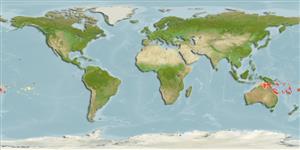>
Eupercaria/misc (Various families in series Eupercaria) >
Labridae (Wrasses)
Etymology: Labropsis: Greek, labrax, -akos = a fish, Dicentrarchus labrax + Greek,opsis = appearance (Ref. 45335).
More on author: Randall.
Environment: milieu / climate zone / depth range / distribution range
Écologie
marin récifal; profondeur 2 - 55 m (Ref. 2334). Tropical; 9°S - 24°S (Ref. 2137)
Western Pacific: Solomon Islands, American Samoa, Vanuatu, Fiji, Loyalty Islands in New Caledonia, Tonga and Great Barrier Reef.
Taille / Poids / Âge
Maturity: Lm ? range ? - ? cm
Max length : 10.5 cm TL mâle / non sexé; (Ref. 2334)
Épines dorsales (Total) : 9; Rayons mous dorsaux (Total) : 12; Épines anales: 3; Rayons mous anaux: 11.
Inhabits shallow reef areas with high coral cover (Ref. 9823). Adults feed on coral polyps while juveniles take ectoparasites and possibly mucus of other reef fishes (Ref. 9823).
Life cycle and mating behavior
Maturities | Reproduction | Spawnings | Egg(s) | Fecundities | Larves
Oviparous, distinct pairing during breeding (Ref. 205).
Randall, J.E., G.R. Allen and R.C. Steene, 1990. Fishes of the Great Barrier Reef and Coral Sea. University of Hawaii Press, Honolulu, Hawaii. 506 p. (Ref. 2334)
Statut dans la liste rouge de l'IUCN (Ref. 130435)
Menace pour l'homme
Harmless
Utilisations par l'homme
Outils
Articles particuliers
Télécharger en XML
Sources Internet
Estimates based on models
Preferred temperature (Ref.
123201): 24.9 - 28, mean 26.8 °C (based on 124 cells).
Phylogenetic diversity index (Ref.
82804): PD
50 = 0.5156 [Uniqueness, from 0.5 = low to 2.0 = high].
Bayesian length-weight: a=0.00955 (0.00456 - 0.02002), b=3.06 (2.89 - 3.23), in cm total length, based on LWR estimates for this (Sub)family-body shape (Ref.
93245).
Niveau trophique (Ref.
69278): 3.9 ±0.61 se; based on food items.
Résilience (Ref.
120179): Haut, temps minimum de doublement de population inférieur à 15 mois (Preliminary K or Fecundity.).
Fishing Vulnerability (Ref.
59153): Low vulnerability (10 of 100).
Nutrients (Ref.
124155): Calcium = 103 [61, 190] mg/100g; Iron = 0.797 [0.451, 1.508] mg/100g; Protein = 18.6 [15.7, 20.8] %; Omega3 = 0.188 [0.113, 0.312] g/100g; Selenium = 25.1 [13.6, 47.4] μg/100g; VitaminA = 166 [49, 671] μg/100g; Zinc = 1.73 [1.14, 2.67] mg/100g (wet weight);
